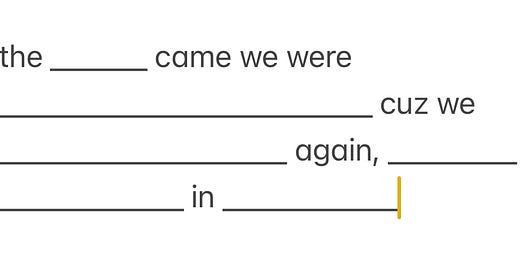Masterful repetition in song lyrics
My mom’s biggest gripe with Taylor Swift is that she’s “too repetitive”. One chorus in to “haters gonna hate hate hate”, you can bet my mom’s gonna shake, shake, shake her way to a different playlist.
But as a songwriter, one of the most valuable lessons I’ve learned from Taylor Swift is repetition.
It’s actually something I nerd out over quite a bit, and I’ve been looking for an outlet for a good Masterful Repetition Nerd Out. So, I thought I’d write an article about good repetition in song lyrics, using three Taylor Swift songs as my main examples.
Haters gonna ______
Hooky repetition
Ask the average non-Taylor Swift fan to finish that sentence and there’s a good chance they’ll burst into song.
The main way repetition is used in pop music is to create hooky choruses. These are the ear worms that get stuck in your head, dominate the charts, and teach the words before the songs even over.
“Shake It Off” might be a source of cringe for a lot of people, but it’s a single for a reason. You can’t deny the hit is catchy and fun.
A big part of what makes it so fun is its sing along-ability. While songs like “Cruel Summer” are bigger hits, “Shake It Off” is perhaps Taylor’s most sing-along-able song.
When the _____ came we were ___________
Poetic repetition
“Maroon” is the song that first inspired this article, a concept that’s been cooking in the back of my head since its release. On the surface, “Maroon” is a moody, synth-pop song recalling a love lost long ago. But when you dig in, you notice something really cool about the lyrical structure.
The verses of “Maroon” function like a poetic game of mad libs.
Both verses of “Maroon” start with this basic structure. The first fills the blanks in with:
And the second:
“Maroon” is a masterful song because the verses appear to be lackadaisical run-on sentences with no real structure, but they’re actually some of the most structured in Taylor’s discography.
It’s full of motifs and call-backs, the two verses echoing each other with rhyme scheme, syllable count, and wording while continuing the story and supplying vivid imagery.
“Your roommates cheap-ass screw-top rosé” becomes “carnations you had thought were roses”. Meaning wise very different, but the words are just beautiful in the way they mirror each other. It’s poetry put to music.
This strict, but not restricting poetic structure demonstrates Taylor’s mastery of language. She also dabbled with this years before in “Out of The Woods”.
The verses to “Out Of The Woods” mirror and build off of each other in a similar way. Each one starts with the phrase “looking at it now” and ends with the words “I remember” before launching into the hooky (remember Shake It Off’s style of repetition?) chorus.
In “Out Of The Woods”, this style of repetition serves to capture the feeling of Taylor’s overthinking. She’s going over and over the events of this failed relationship in her mind, unable to move on.
I think ____ did it, but ___ just can’t prove it
Narrative repetition
Finally, we have the style of repetition that helps build a narrative and move the story along.
“No Body, No Crime” is another example of a Taylor Swift song with a repetitive chorus and more subtly repetitive verses. Poetically, each verse starts with the name “Este” and a mention of Tuesday night. Each line of the bridge starts with the words “good thing” as well.
But the narrative repetition happens mostly in the pre-chorus. The first two times we hear it, the words are exactly the same: “I think he did it, but I just can’t prove it”.
Thanks to the second verse adding new context to the story, those same words have completely changed in meaning.
The first time, the “it” that he did was adultery. The chorus: “no body, no crime” simply means she has no real proof that he cheated.
By the second pre-chorus, Este is missing and the husband’s truck has some brand new tires. We understand easily that the “it” in question is now murder. When she says “no body, no crime”, she now means it literally.
The genius here is so subtle, it’s easy to miss. The words stay the same, but we understand them differently based off the changing context.
By the last chorus, those same words “no body, no crime” have once again morphed: now it’s the mistress who thinks Taylor did it, but just can’t prove it.
Haters gonna hate, but Taylor’s repetition is actually pretty dang cool
Like all things music, I’m always listening with songwriting inspiration somewhere on my mind. No one’s had a bigger impact on my songwriting journey than Dr. Taylor Allison Swift.
I see these little repetitive tricks as tools to play around with. Try repeating a word or two to quickly make a chorus catchier and more sing-along-able. Challenge yourself to following a strict poetic structure and see how that wordplay can shape your verses. Tell a story where the same lyrics change meaning as you add contrast.
If you’ve read this far, thanks for letting me nerd out about Taylor Swift, repetition, and “Maroon”. If you can think of any other songs, Taylor Swift or otherwise, that demonstrate these concepts, let’s talk about it in the comments! Nothings more fun to me than dissecting lyrics.






